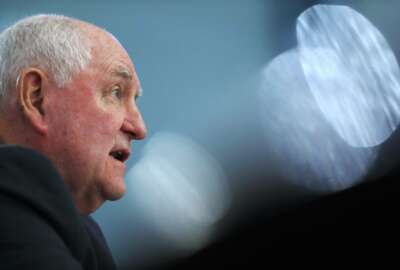
Agency reopening strategies earn criticism from both sides of the aisle
As Congress and agencies debate reopening plans, Rep. Gerry Connolly (D-Va.) introduced two bills designed to publicize those plans, as well as provide child care...
As agencies reopen their offices to their employees and the public, members of Congress largely agree: government should set an example in how it recalls its workforce back to the physical work site.
But few seem to agree on what that model should look like.
Rep. Gerry Connolly (D-Va.), chairman of the House Oversight and Reform Subcommittee on Government Operations, introduced two new bills in an attempt to clarify agency reopening plans and provide child care subsidies, hazard pay and other benefits to employees.
Under the first bill, employees who are required to report to their work sites would receive child care subsidies of up to $2,000 a month.
It would also authorize hazardous duty pay to employees working on the frontlines of the ongoing pandemic.
Another bill requires agencies to publish their plans for returning federal employees back to their work sites at least 30 days before reentry. Specifically, it calls on agencies to detail their plans for providing personal protective equipment to employees, implementing social distancing protocols and protecting workers who interact with the public.
The bill is named after Chai Suthammanont, one of Connolly’s constituents who died due to complications from coronavirus. He worked at a child care facility at Marine Corps Base Quantico in Virginia.
“Our federal workforce is our nation’s greatest asset. It is our duty to protect the health and safety of the millions of public servants who have continued to work throughout this pandemic,” Connolly said during a hearing Thursday. “During the coronavirus pandemic, the federal government never shut down. In fact, our federal workforce has continued to work throughout this unprecedented time and has even ramped up its efforts to ensure that the public has access to critical services.”
But the hearing, initially billed as an examination of how government could protect federal employees working on the front lines of the pandemic and continue providing services to the public, quickly became politically charged.
“There should be no reopening unless and until federal agencies have the full capacity to test, protect, trace and inform their workforces, and unless and until genuine, objective data on the status of the pandemic shows it has subsided,” Jacque Simon, national policy director for the American Federation of Government Employees, told the subcommittee. “Where there’s resurgence we should have re-closing, not reopening.”
But at least a few subcommittee members expressed some frustration that federal agencies, from their perspective, have been slow to reopen to the public.
Rep. Glenn Grothman (R-Wis.) said he’s waiting for the IRS to open its offices in his district, where his constituents were impatient for their tax refunds.
“What is the hypothetical rationale for saying the federal workforce cannot open with the private sector workforce?” he said. “What do I tell people back home who are working and waiting for their tax refund for months because the [IRS] office is closed, while they’ve been working throughout this whole thing?”
Rep. Ralph Norman (R-S.C.) questioned the demands federal employee unions have made of agencies in preparing to reopen. AFGE, the National Treasury Employees Union and the Federal Worker Coalition have all called on agencies to provide personal protective equipment and provide a comprehensive testing strategy for workers, among other suggestions.
“It seems to obstructing the idea of getting back to full employment at the federal level,” Jim DeMint, a former senator and now chairman of the Conservative Partnership Institute, said of the unions’ reopening goals. “We need to allow some flexibility. If you have an office of younger workers, all of those demands make very little sense. They can be guidelines, and we can certainly study them. Maybe in some cases they need to be mandated. But I just don’t think this is a time for federal employee unions to be taking a stand that’s much, much stronger than you’re going to see in the private sector.”
For Connolly, the reopening guidance from the Office of Management and Budget and Office of Personnel Management doesn’t go far enough to assure federal employees they’ll be safe at work.
“It’s incomplete, unclear, fails to prioritize the health and safety of federal workers,” he said. “In fact, it’s so confusing that agency leaders don’t know where to turn for data and evidence to determine whether their reopening is safe. Federal workers have no idea what’s happening. There’s no mention of PPE, testing or even any thought of contingency plans if the virus should re-surge.”
In resuming more normal operations, the Government Accountability Office is encouraging agencies to establish two-way lines of communication, urging them to “aggressively” seek out employee concerns.
GAO has asked agencies for their reopening playbooks, which it will then review and compare to look for common themes and practices. In two separate reviews, GAO is also studying agency telework policies and the technology they’re using to support remote work.
“Very importantly in our view, agencies’ experiences with telework during the current pandemic suggest opportunities for increased availability with telework in the future,” Chris Mihm, managing director for strategic issues for GAO, said.
Mihm said GAO itself has been highly productive — perhaps more so — while teleworking during the pandemic. In a Federal News Network survey, employees have said they too have been working longer hours while at home.
“Since so many have been teleworking successfully during the pandemic, I inevitably ask: why the rush to return? ” Simon said. “It’s clear that in many locations, the rush is motivated by politics, not the health and safety of the community.”
Lorraine Martin, president and CEO of the National Safety Council, said agencies should consider whether traditional work arrangements are still necessary for every federal job.
“For workers who serve at a desk with a computer for most of their day and who likely have been working at home in the past weeks, decision-makers should not rush to require them to report to a traditional office if it isn’t necessary,” she said.
Ultimately, Connolly said federal employees need confidence that their agencies are doing all they can to keep them safe at the workplace.
“No one wants to be shut down; it has big economic consequences as we all know,” Mihm said. “But we have to have confidence, and employees have to have confidence, that as we reopen they’ll be safe in their workplaces and they’ll be safe in their interactions with the public. And the public needs to have confidence that they’ll be safe in their interactions with government.”
Copyright © 2025 Federal News Network. All rights reserved. This website is not intended for users located within the European Economic Area.
Nicole Ogrysko is a reporter for Federal News Network focusing on the federal workforce and federal pay and benefits.
Follow @nogryskoWFED
Related Stories





